Featured Stories
The Winter Dance Party 1959: The Night the Music Lived
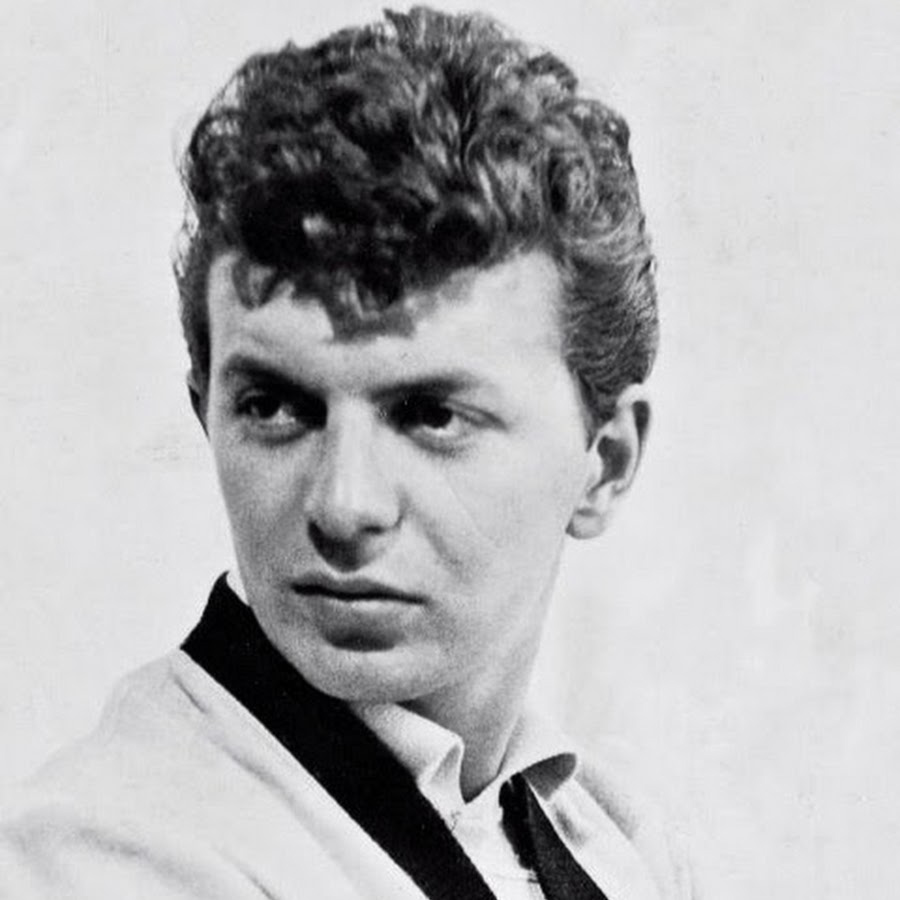
Dion DiMucci.
On February 3,, 1959, while sitting on the broke-down school bus in Fargo, Minnesota, Dion DiMucchi couldn’t feel the weight of the tragedy that had just fallen on his friends. He was numb with disbelief and the cold. The night before, Buddy asked him, “Take care of my guitar.” In that moment he stared at the beautiful, orphaned Fender Stratocaster and wept inside. The grim news came over the black-and-white television in the hotel lobby. “Three rock ‘n’ roll idols dead in plane crash.” Dion stopped, looked up, and prayed.
In the history of American air disasters none was more pivotal and influential on the music of the times than the crash of the infamous single-engine Beechcraft Bonanza on one frigid early morning on February 3, 1959, in Clear Lake, Iowa. The small aircraft carried three of the most promising young stars of rock ‘n’ roll music: Buddy Holly, J.P. Richardson (the Big Bopper), and Richie Valens.
On that cold, dark night chance and fate would converge into a perfect storm that would forever alter the course of popular music.
In 1959, the genre known as rock ‘n’ roll was in its infancy and experiencing growing pains. Its founding artists began to settle into their fame along with personal crises, scandals, and the compromises that inevitably followed. Elvis, the undisputed king, was in the army and would soon return to Hollywood to focus on movie stardom. His heir apparent, the wild firebrand, Jerry Lee Lewis, was embroiled in a scandal after the news broke that he was married to his 13-year-old second cousin. His popularity and credibility took a severe bruising and derailed his belief that he was poised to take the crown from Elvis.
On the horizon the established and conservative music industry had found ways to whitewash the music of founding artists like Bo Diddley and Little Richard with cover versions by the likes of the white-bucked, wholesome Pat Boone. Others, tamed and toned-down crooning vocalists and teen idols, were waiting in the wings to water down and bury the restless growth of the rebellion-based rock music of the previous decade.
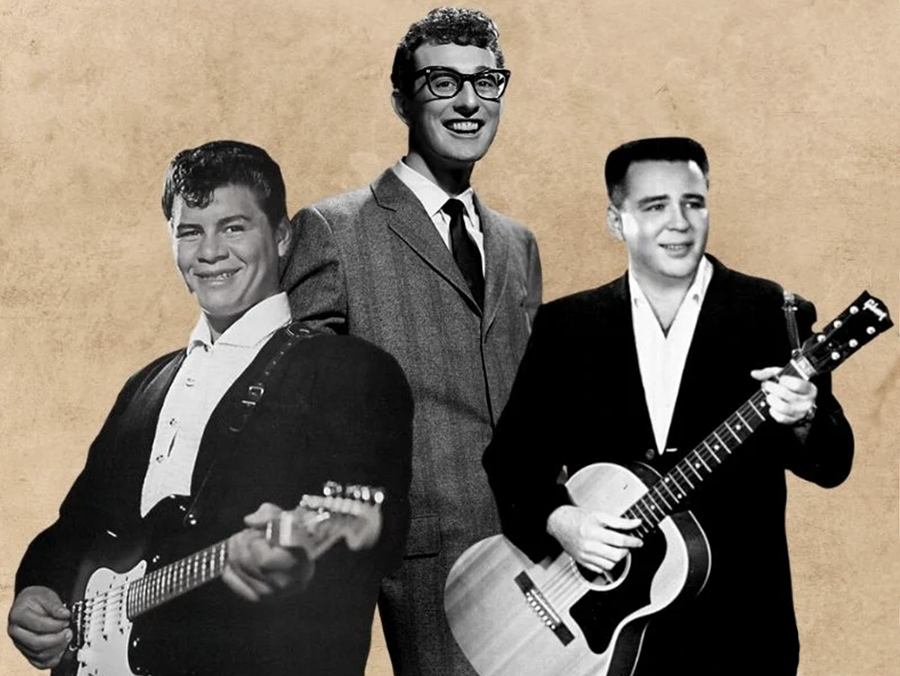
Richie Valens, Holly, the Big Bopper.
Ironically, the combined talents of the bill that included the Big Bopper, Buddy Holly, Richie Valens, and Dion and the Belmonts represented an undercurrent of hope for the new genre. All three artists were on the cusp of breaking out toward the kind of success that would revive rock ‘n’ roll in new and inventive ways. It could be justifiably argued that, four years later, these artists helped prepare the way for the British Invasion that had reached American shores four years later. The dream seemingly went down in flames that winter night. But, did it really? Today, Dion DiMucci quotes the Bible, “Unless a grain of wheat falls to the ground and dies, it remains only a single seed. But if it dies, it produces many seeds.”
Buddy & the Crickets on the Ed Sullivan Show!
The youngest of the passengers, 17-year-old Richie Valens, had just hit the charts with the hit romantic ballad “Donna.” However, the flipside was the groundbreaker, “La Bamba,” which would open the doors for other successful Hispanic artists like Sam the Sham and the Pharaohs, Question Mark and the Mysterians, Thee Midnighters, Santana, and Los Lobos.
In 1958, J.P. Richardson, an army veteran, radio programmer/DJ, songwriter and comedian, charted his first hit, the self-penned, “Chantilly Lace,” which gave way to his humorous side as the Big Bopper, a name he adopted during his days as a disc jockey in Beaumont, Texas. He loved country-western and rock ‘n’ roll. In fact, Richardson’s original song, “White Lightning,” was released by young country singer George Jones in February of 1959. It became Jones’ first #1 single release in February of 1959.
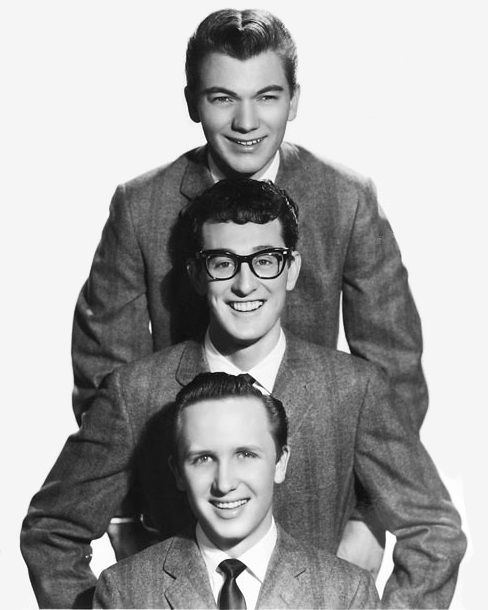
Buddy Holly & the Crickets. From top: Jerry Allison, Holly, Joe Mauldin.
The center of the celebrity storm of the historic tour was without question the young singer-songwriter and rock n roll genius from Lubbock, Texas—Charles Hardin Holley—who came to be known as Buddy Holly. His music drew from his vintage country roots. He spent years absorbed in the traditional music of the South. However, rhythm and blues got ahold of him in 1955. It was the year Buddy and Jerry Allison opened for Elvis at a Lubbock concert, which became a turning point for the young artist. According to Crickets’ drummer, Allison and Joe Mauldin before opening for Elvis, they were country musicians. After Elvis came to town, they became full-fledged rock ‘n’ rollers. The music changed. And Buddy began writing with a new, driving intensity.
But, Holly’s metabolic creative sensibility ran faster than Elvis and the Founding Fathers of Rock ‘n’ Roll. He was a singular visionary without peer. In his brief recording career, he surveyed country music and rock ‘n’ roll, and at the end of his life he used string arrangements and championed vocal pop songs like Paul Anka’s “It Don’t Matter Anymore,” and “Raining in my Heart,” written by Felice and Boudleaux Bryant. He demanded and received control over the studio production and publishing of his songs. This was new to rock ‘n’ roll. Many have stated that he invented the tradition of the four-piece band as a self-sustaining unit with two guitars, drums, and a bass, an arrangement that would become the norm for rock bands over the next 60 years, including the Beatles.
Although Holly was one of the most successful artists of his day, he was cash poor due to disputes with his manager, Norman Petty, over past publishing rights and payments owed to Holly and the band. Petty held back much-needed income for Holly and the Crickets.
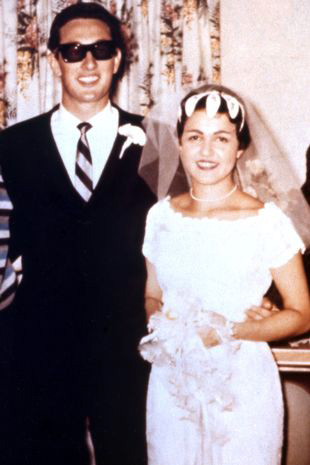
Buddy and Maria.
Then, in 1958, he moved to the New York City. Holly’s marriage to Puerto Rican immigrant and secretary at Southern Publishing, Maria Elena Santiago, and the attraction of the control he would gain over his career made his move to the Big Apple inevitable. Holly and his new bride moved to Washington Square Park in Greenwich Village, which, in 1958, was Ground Zero for the Folk Music Revival that produced Bob Dylan, Tom Paxton, and Joan Baez. With the original Crickets out of the picture, Holly hired other Texas musicians, including up-and-coming talents like Tommy Allsup on lead guitar, future country star and Lubbock native Waylon Jennings for bass, along with Carl Bunch on drums.
The Winter Dance Party Tour seemed like a good idea—in theory—to raise record sales and radio play, but the reality began to set in with the surge of bad weather that covered the Midwest. The General Amusement Company (GAC) attracted Holly with the promise of a tour in England. On the evening of his death, he was already making plans to include the original Crickets. Unfortunately, the Winter Dance Party came first; it was as ill-fated as the sinking of the Titanic.
At GAC there was an extreme lack of consideration for the artists. From January 23rd to February 15th, 24 consecutive shows were scheduled, crisscrossing the Midwest without consideration of distance or sequential locations.
The final blow to the well-being of the artist was the chartered bus fleet, which consisted of “reconditioned” school buses that were not equipped the for harsh Midwestern weather. According to most reports, as many as five replacement buses were used with broken heating systems and the need for constant repairs. To add insult to injury, there was no road crew, so the artists hauled their own equipment.
The contrast between the shoddy and negligent tour conditions provided by GAC and the artist line-up couldn’t have been more stark. According to eye-witness interviews found on YouTube, the shows were entertaining, exciting, and well-performed. The audience could not see the discomfort and illness that was descending on the artists.
On January 31, 1959, in the audience at the Duluth National Guard Armory was a young singer-songwriter from Hibbing, Minnesota. Bob Dylan was left mystified by the experience of the Duluth show, as he said in his Nobel Prize Lecture in 2017,
If I was to go back to the dawning of it all, I guess I’d have to start with Buddy Holly. Buddy died when I was about 18 and he was 22. From the moment I first heard him, I felt akin. I felt related, like he was an older brother. I even thought I resembled him. Buddy played the music that I loved—the music I grew up on: country western, rock ‘n’ roll, and rhythm and blues. Three separate strands of music that he intertwined and infused into one genre. One brand. And Buddy wrote songs—songs that had beautiful melodies and imaginative verses. And he sang great—sang in more than a few voices. He was the archetype., everything I wasn’t and wanted to be. I saw him but only once, and that was a few days before he was gone. I had to travel 100 miles to get to see him play, and I wasn’t disappointed. He was powerful and electrifying and had a commanding presence. I was only six feet away. He was mesmerizing. I watched his face, his hands, the way he tapped his foot, his big black glasses, the eyes behind the glasses, the way he held his guitar, the way he stood, his neat suit. Everything about him. He looked older than 22. Something about him seemed permanent, and he filled me with conviction. Then, out of the blue, the most uncanny thing happened. He looked me right straight dead in the eye, and he transmitted something. Something I didn’t know what… and it gave me the chills. —Bob Dylan
Later in 1959, Dylan would play piano on stage with Bobby Vee. Vee and his band volunteered to play the Fargo show that followed the Clear Lake plane crash to take Buddy Holly’s place on the bill. It started Vee’s career, which included several hit records in the decade that followed.
When the tour drove into Clear Lake’s Surf Ballroom on February 2nd, the toll taken on the performers was as severe as the cold weather. Buddy Holly’s drummer, Carl Bunch, contracted frostbite due to the lack of heat on the bus. He was taken to a nearby hospital. This left the show without a drummer as Buddy’s musicians were the tour band for the show. So, Richie Valens and Buddy Holly provided drums for each other, with Buddy playing for Richie and Richie for Buddy’s set. In an interview, Dion spoke with amazement that this was the night Buddy Holly became the drummer for Dion and the Belmonts.
Because the tour conditions were so hard on its performers, Buddy Holly decided to charter a plane to fly ahead and get some much-needed rest. The Big Bopper came down with the flu and was unable to rest on the broken bus. Richie Valens, accustomed to the moderate climate of Southern California, had a cold and was miserable, prompting his mother to send him a jacket.
Buddy Holly decided to charter a flight for him and his band, which included bassist Waylon Jennings and guitarist Tommy Allsup. Dion DiMucci, in an online interview, said he was offered a seat if he paid $36. This was the same amount his parents had to pay for rent in the Bronx. For Dion, this was a sign that led him to decline the seat on the plane.
Jennings, after talking with Holly, gave up his seat to the Big Bopper. When he told Holly about the change, Holly scoffed and said, “Well, I hope your old bus freezes up!” Waylon Jennings retorted back, “Yeah? Well, I hope your old plane crashes!” It was a moment that Jennings would regret and carry for the rest of his life.
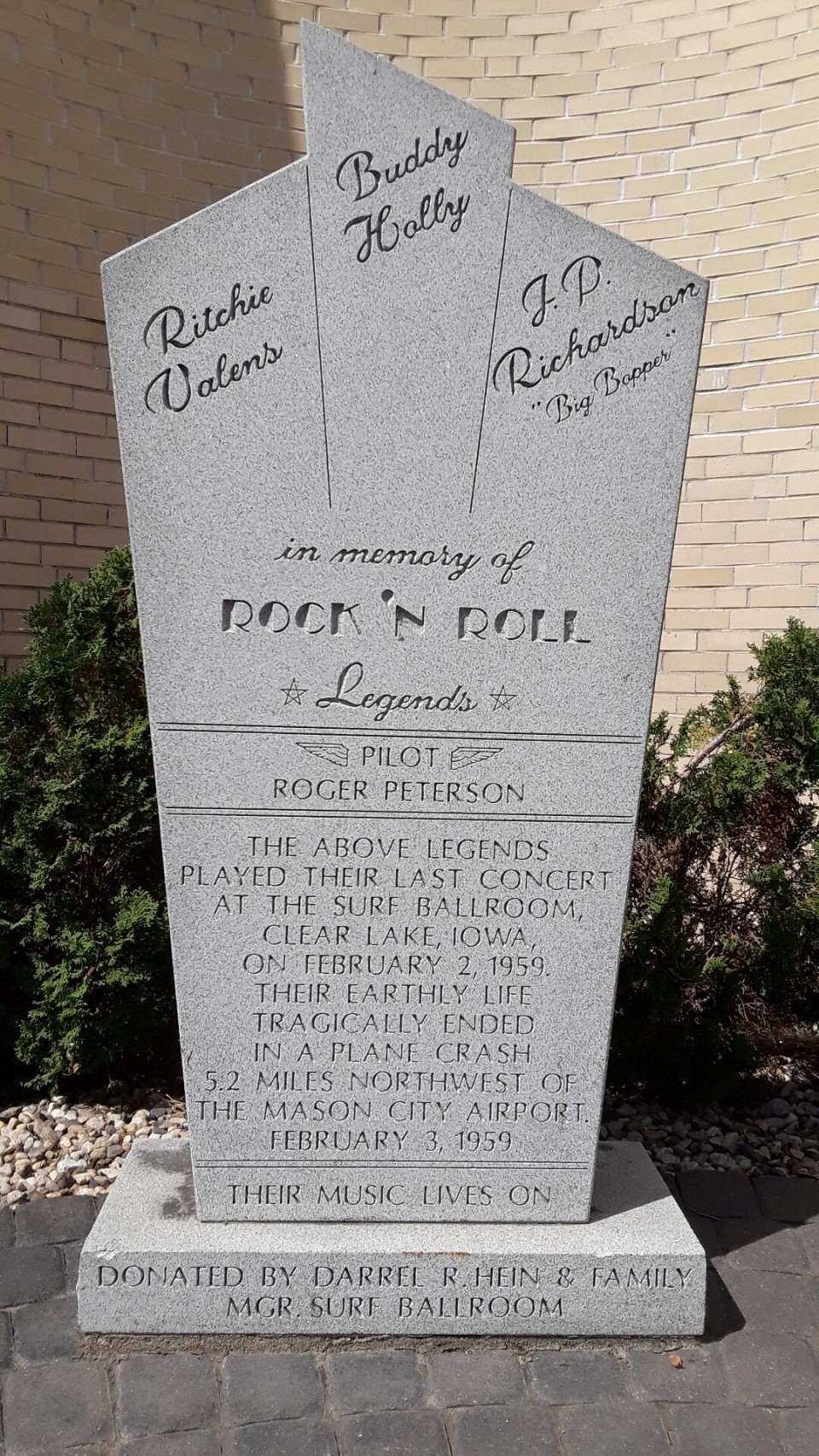
Monument in front of Surf Ballroom.
Richie Valens asked Tommy Allsup for his seat several times during the evening of the show. Finally, at Holly’s request, Allsup returned to the venue to check for equipment left behind and Valens asked for his seat on the plane again. This time, Allsup offered a coin toss. Richie Valens called heads and won the seat. Allsup said he experienced survivors’ guilt after the tragedy. When he opened a successful club in Texas, he called it Heads Up in honor of Richie Valens and that moment.
The Dwyer Charter Company called on 21-year-old Roger Peterson to pilot the trio to Fargo, Minnesota for their Moorhead show. The severity of the weather and an oncoming snowstorm was not reported to the pilot or the charter company. Peterson was an experienced pilot but had not been cleared for flying by instruments, which was necessary in a snowstorm. But Peterson was disoriented disoriented, and the plane crashed into a cornfield five miles from the airport, instantly killing all on board.
What followed was confusion, grief, shock, disbelief, and sadness. The event would later be immortalized in Don McLean’s “American Pie,” where it was described as “the day the music died.” But this wasn’t exactly true. The songs of Buddy Holly, Richie Valens, and J.P. Richardson never died. Bruce Springsteen and the Bible agree that when a thing seems to die, “everything that dies someday comes back.” All three artists’ music and stories would return and become part of the stories of America in the mid-20th century.
Buddy Holly, his imagination, his commitment to the music, and his innovations have inspired generations for the last 63 years. The families, friends, and fans lost the gift of Buddy Holly, Richie Valens, and J.P. Richardson to a tragically early death. In many ways, this was the first time the teenagers of the day experienced this kind of loss. But the influence and memory remain through their love of the music, their peers, and fans. It was their love and passion that kept them on the icy road that February night in Iowa. “Everything that dies, some day comes back.” It seems they never left the building or our hearts.
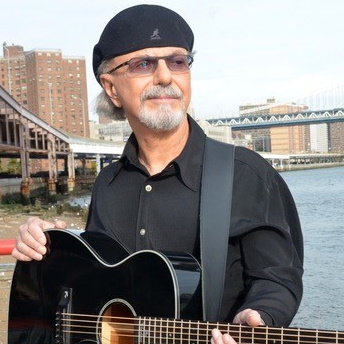
Dion in 2013.
These days, at 83, Dion DiMucci is in the long lion-winter of his good life. His years have been many, unlike his friends from so long ago. But he still remembers, as he sings a recent song he wrote with shadows of the night still peering through the lyrics of “Every Day (That I’m with You).” And, today, he prays with gratitude.
“We dreamed a dream to gather one dark winter night; we found the dream still burned in the warm summer light.” —Dion DiMucci from “Every Day (That I’m with You).”






